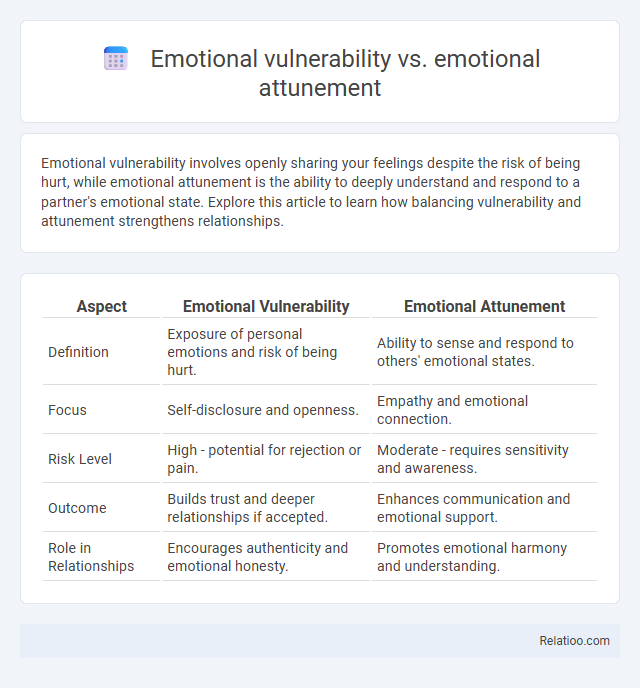Emotional vulnerability involves openly sharing your feelings despite the risk of being hurt, while emotional attunement is the ability to deeply understand and respond to a partner's emotional state. Explore this article to learn how balancing vulnerability and attunement strengthens relationships.
Table of Comparison
| Aspect | Emotional Vulnerability | Emotional Attunement |
|---|---|---|
| Definition | Exposure of personal emotions and risk of being hurt. | Ability to sense and respond to others' emotional states. |
| Focus | Self-disclosure and openness. | Empathy and emotional connection. |
| Risk Level | High - potential for rejection or pain. | Moderate - requires sensitivity and awareness. |
| Outcome | Builds trust and deeper relationships if accepted. | Enhances communication and emotional support. |
| Role in Relationships | Encourages authenticity and emotional honesty. | Promotes emotional harmony and understanding. |
Understanding Emotional Vulnerability
Emotional vulnerability involves openly expressing and experiencing feelings without defense, fostering deep self-awareness and authentic connections. Emotional attunement refers to accurately perceiving and responding to another person's emotional state, enhancing interpersonal sensitivity. Empathic attunement extends this awareness by emotionally resonating with others' experiences, promoting compassion and supportive relationships.
Defining Emotional Attunement
Emotional attunement refers to the ability to accurately perceive, understand, and respond to the emotions of another person, creating a connection that fosters empathy and trust. Unlike emotional vulnerability, which involves exposing one's own feelings, emotional attunement emphasizes tuning into Your partner's emotional state with sensitivity and presence. Empathic attunement extends this concept by not only recognizing emotions but also deeply feeling and resonating with them on an emotional level.
Key Differences Between Vulnerability and Attunement
Emotional vulnerability involves openly expressing your true feelings, often exposing yourself to potential emotional risk, while emotional attunement is the ability to deeply understand and resonate with another person's emotional state without losing your own boundaries. Empathic attunement takes this further by tuning into both the verbal and nonverbal cues to accurately perceive and respond to another's emotions with compassion and insight. Recognizing these key differences helps you navigate relationships more effectively by balancing self-expression with emotional connection and understanding.
The Role of Vulnerability in Emotional Growth
Emotional vulnerability involves openly expressing and experiencing one's true feelings, which fosters deeper self-awareness and authentic connections essential for emotional growth. Emotional attunement refers to accurately perceiving and responding to another person's emotional state, promoting mutual understanding and relational harmony. Empathic attunement extends this process by deeply resonating with others' emotions, enabling compassionate support that strengthens interpersonal bonds and facilitates shared emotional development.
How Emotional Attunement Fosters Connection
Emotional attunement strengthens connection by enabling individuals to perceive and respond accurately to subtle emotional cues, fostering mutual understanding and trust. Unlike emotional vulnerability, which involves openly sharing one's feelings, emotional attunement emphasizes active listening and empathetic responsiveness, creating a safe space for authentic interaction. Empathic attunement builds on this by deeply resonating with another's emotional state, enhancing relational harmony and emotional bonding.
Common Misconceptions About Vulnerability and Attunement
Emotional vulnerability is often mistaken for weakness, but it actually involves courage in expressing genuine feelings, while emotional attunement refers to the ability to accurately perceive and respond to another's emotional state. Empathic attunement goes deeper by not only sensing emotions but also emotionally resonating with them, fostering a profound connection. Your understanding of these concepts can transform relationships by dispelling myths that vulnerability equates to fragility or that attunement is simply sympathy, highlighting their essential roles in emotional intimacy and communication.
The Interplay Between Openness and Responsiveness
Emotional vulnerability involves Your willingness to openly share feelings, creating a foundation for genuine connection, while emotional attunement requires accurately perceiving and responding to those feelings with sensitivity. Empathic attunement deepens this process by not only recognizing emotions but also resonating with the emotional experience of others, fostering deeper understanding. The interplay between openness and responsiveness enhances relational intimacy, as openness invites authentic expression and responsiveness ensures those emotions are acknowledged and validated effectively.
Signs of Healthy Emotional Boundaries
Healthy emotional boundaries are evident through clear recognition of one's own feelings without over-identifying with others' emotions, a key difference between emotional vulnerability and empathic attunement. Emotional vulnerability involves authentic self-expression and openness without allowing others' feelings to override personal emotional state, while emotional and empathic attunement require sensitive awareness of others' emotions paired with maintaining self-distinction. Signs include balanced emotional responsiveness, respectful listening, and the ability to provide support without emotional enmeshment or boundary crossing.
Cultivating Attunement Without Sacrificing Self
Cultivating emotional attunement involves tuning into others' feelings while maintaining your own emotional boundaries to prevent vulnerability from turning into self-sacrifice. Emotional vulnerability opens you to authentic connections, but empathic attunement refines this by balancing your feelings with discernment, ensuring you remain present without losing your sense of self. Your ability to navigate these dynamics with awareness promotes healthier relationships and sustained emotional well-being.
Practical Steps to Balance Vulnerability and Attunement
Balancing emotional vulnerability and attunement requires recognizing personal feelings while staying present to others' emotional cues through mindful listening and reflective responses. Practicing self-awareness and regulating emotional expression ensures open communication without overwhelming either party. Cultivating empathic attunement involves validating others' experiences and maintaining emotional boundaries to foster genuine connection and mutual trust.

Infographic: Emotional Vulnerability vs Emotional Attunement
 relatioo.com
relatioo.com